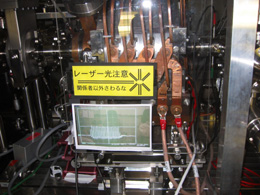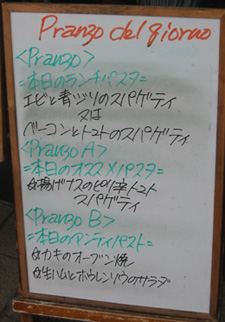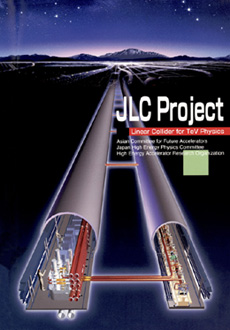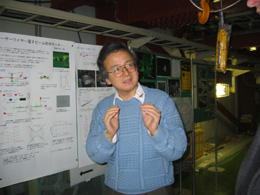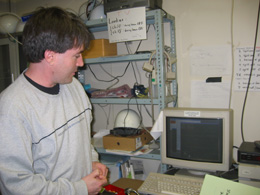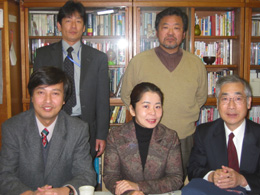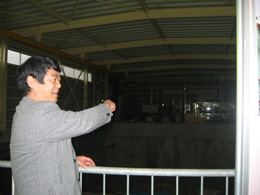 |
|
A Visit to Tsukuba Particle physics in Japan's City of Science
by Judy Jackson When you come from a high-energy physics lab,every other high-energy physics lab feels like home.Although Japan ’s KEK laboratory is 6,000 miles from Chicago,a visitor from Fermilab instantly recognizes the hallmarks of a busy accelerator laboratory.The physicists in the control room tracking the accelerator ’s performance,the graduate student at his terminal in a portakamp,the high-tech magnet test facilities painted in primary colors, the crumpled aluminum foil swaddling the light-source beamlines —these are the same at physics laboratories the world over.Seeing them in this far-off place,gives the visitor a new appreciation of the simultaneous uniqueness and universality of this undertaking called particle physics.
Founded in 1971, Koo Energy Ken, the High Energy Research Accelerator Organization in Tsukuba (“The City of Science ”),Japan is a high-energy laboratory in every sense of the term.At any given moment,there is a lot going on.On an early afternoon last month, an atmosphere approaching euphoria pervaded the control room of KEK-B,the electron-positron collider that creates B mesons for the BELLE experiment.The accelerator had just completed its 54th hour of continuous operation without a hiccup,a new record for the accelerator and a fire hose of data for the BELLE collaborators.The machine ’s current performance was especially gratifying because of the slow start-up it experienced when it began operating in 1999.Initially far outpaced by its sister B factory,PEP II at the Stanford Linear Accelerator Center,KEK-B ’s luminosity has steadily and convincingly risen to its present record-breaking levels.At the bottom of each of the screens monitoring KEK-B ’s performance appears a window showing how PEP II is doing today.Just in case you wondered if anyone was paying attention.
The BELLE collaborators comprise some 300 physicists from 49 institutions in 10 countries,including the US.The BELLE experiment will use the deluge of B mesons from the accelerator to elucidate the mysterious difference between matter and antimatter.Earlier experiments at other laboratories have seen this matter-antimatter asymmetry,called “CP violation ”in physics-speak, in subatomic particles called kaons.Between them,BELLE and BaBar will reveal how this phenomenon works in the realm of the kaons ’cousins,the B mesons.Papers at physics conferences this year will relate the next chapter of this unfolding story,one of the more exciting adventure sagas of 21st century particle physics. Across the KEK campus at the Accelerator Test Facility,accelerator physicists from the U.S.,Europe, Korea,Russia and China are collaborating with Japanese colleagues to develop ultraconcentrated beams of high-energy electrons and positrons for the next generation of linear colliders.For a linear collider to achieve the collision rates that experiments of the future will require,the beams of electrons and positrons must be focused at the collision point to dimensions as small as three nanometers,a degree of focusing that KEK ’s website understandably calls “almost outrageous.”
KEK also does neutrinos. In June,1998,the Super-Kamiokande experiment,located 250 kilometers north of Tsukuba,announced evidence for neutrino oscillations,and hence neutrino mass, based on observations of atmospheric neutrinos. In 1999,the K2K (KEK to Kamioka)long-baseline neutrino experiment began sending a beam of accelerator-produced neutrinos from KEK ’s 12 GeV proton synchrotron to the Super-Kamiokande detector.Like the NuMI experiment that will begin operating at Fermilab in 2004,K2K also includes a “near ”detector to characterize the beam of neutrinos as it leaves the laboratory site. Experimenters use the “far ”Super-K detector to look for signs of oscillation in this controlled neutrino beam. The course of the K2K experiment has not always been smooth.Collaborators made an extraordinary recovery from what many feared might be a fatal blow.
In the autumn of 2001,a phototube at the bottom of the Super-K detector imploded, causing a devastating chain reaction that broke about 7,000 of the detector ’s 11,000 phototubes and covered the bottom of the detector with broken glass and debris. Collaborators immediately announced their intention to rebuild the detector.The experiment resumed operations in December 2002 with about 50 percent of the phototubes replaced. Besides its high-energy physics experiments and R & D facilities,KEK also operates the Photon Factory,a synchrotron light source whose many beamlines support dozens of experiments in mater- ials science,protein crystallography,biomedicine, biophysics,x-ray lithography and photochemistry.
ACFA SYMPOSIUM
The Asians were continuing a tradition established at the Deutsches Elektronen Synchrotron Laboratory in March,2000,when DESY officials held a symposium in Hamburg to present the Technical Design Report for the TESLA Project,that laboratory ’s vision for a German-based international linear collider.Now it was Japan ’s turn to present its proposal to society,the high-energy equivalent of a sort of coming-out party for linear colliders. A series of speakers beginning with KEK Director- General Hirotaka Sugawara filled in the picture of an internationally supported project to build the world ’s next-generation high-energy particle accelerator in Japan. The symposium’s objective,as defined by the organizers,was “to explore the scope of the ACFA Linear Collider Project:scientific challenges, overall design of the project including accelerator technology,cost,site and organizational aspects, and a road map towards the realization of the project.” The complete road map for the JLC Project,including physics goals,technology,site studies,cost and proposed global organization, appears on the World Wide Web at http://lcdev.kek.jp/RMdraft/ In his opening remarks,Sugawara told the audience of more than 360 that the report “is not a proposal to our government,but we want our government to think about it.We are presenting our proposal to the world community,to officials and politicians to think about.”
One of the first things to think about,speakers acknowledged,is what to call the project.Although the “J ”in the term “JLC ”was conceived to stand for “Joint,”not “Japanese,”symposium speakers recognized the possibility of confusion.A sub- committee of ACFA,charged with choosing an appropriate name,was reported to be considering four dozen candidate proposals for a new title. In the meantime,a new abbreviation,“GLCC,” for “Global Linear Collider Center,”emerged to describe a proposed new form of international laboratory organized specifically to build and operate a new linear collider. “Such a global laboratory,”the JLC Project Report ’s Executive Summary says,“unprecedented in the field of particle physics,could serve as an outstanding center of excellence in Asia and would have considerable impact on the whole world.” Among the ACFA Symposium’s most powerful messages were remarks by 2002 Nobel laureate Masatoshi Koshiba,of Tokyo University, who emphasized the imperative for nations and generations to work together for the success of a linear collider. “From Asia to the world,”Koshiba said,“let ’s get together!”
|
